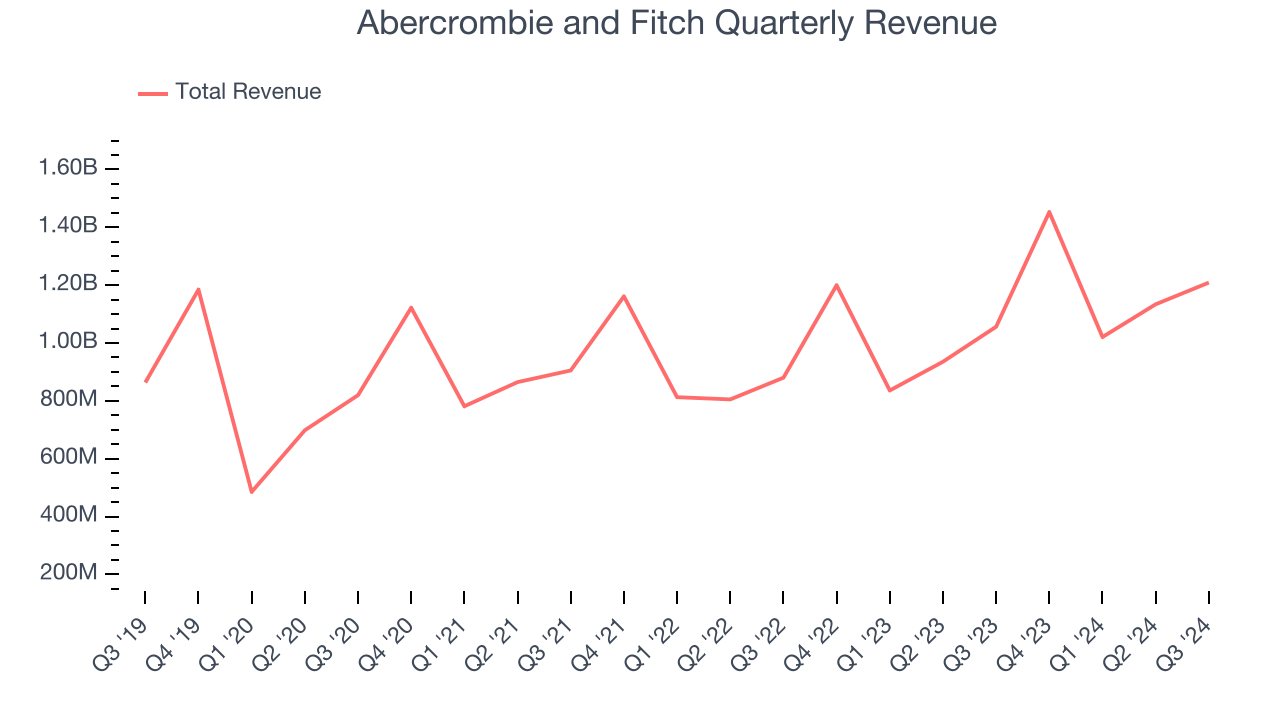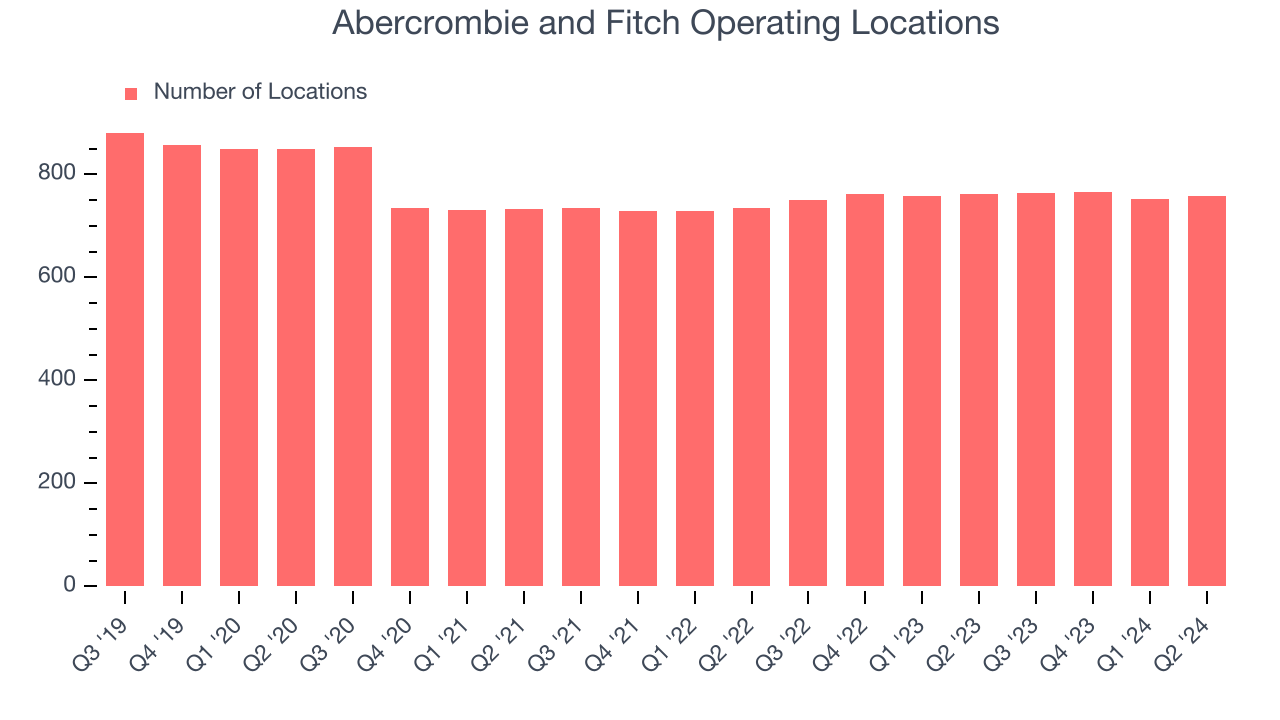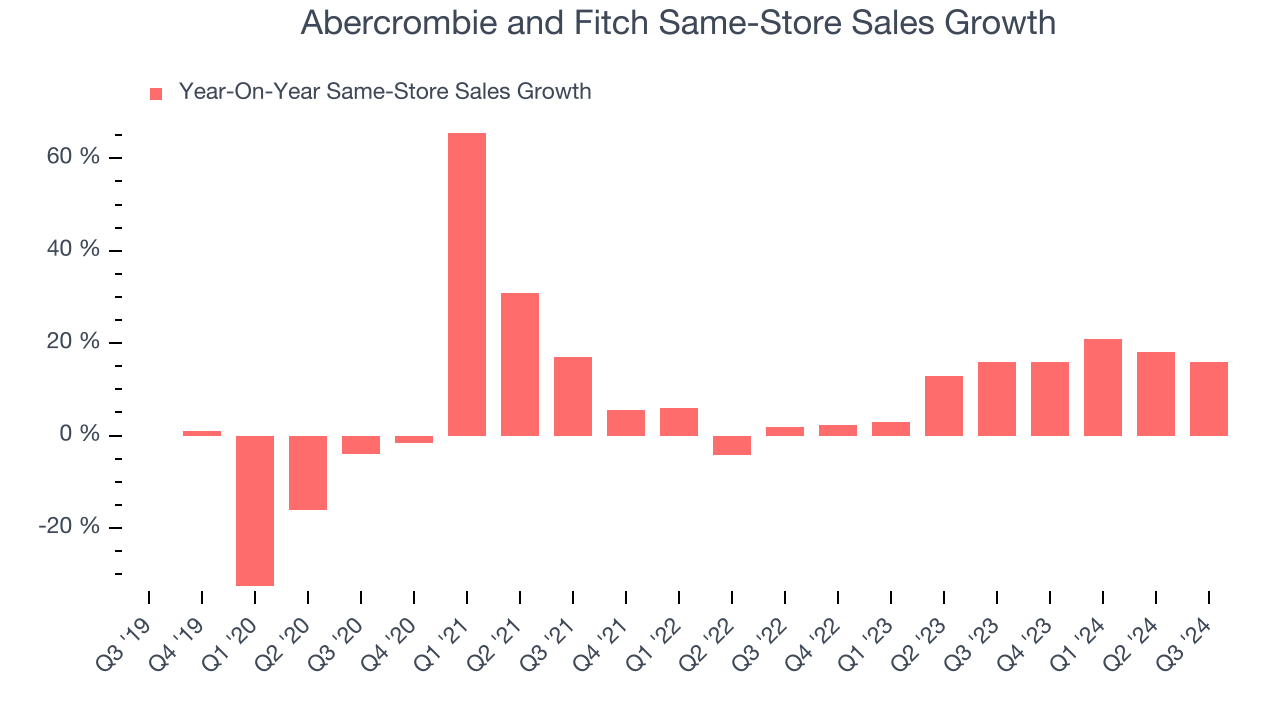
Young adult apparel retailer Abercrombie & Fitch (NYSE:ANF) reported Q3 CY2024 results topping the market’s revenue expectations, with sales up 14.4% year on year to $1.21 billion. Its non-GAAP profit of $2.50 per share was 6.4% above analysts’ consensus estimates.
Is now the time to buy Abercrombie and Fitch? Find out by accessing our full research report, it’s free.
Abercrombie and Fitch (ANF) Q3 CY2024 Highlights:
- Revenue: $1.21 billion vs analyst estimates of $1.18 billion (14.4% year-on-year growth, 2.7% beat)
- Adjusted EPS: $2.50 vs analyst estimates of $2.35 (6.4% beat)
- Adjusted EBITDA: $218.8 million vs analyst estimates of $206.2 million (18.1% margin, 6.1% beat)
- Q4 sales guidance of 5-7% growth (slight beat vs expectations of 5% growth)
- Raised full year sales guidance to 14-15% growth (12-13% previously)
- Operating Margin: 14.8%, up from 13.1% in the same quarter last year
- Same-Store Sales rose 16% year on year, in line with the same quarter last year
- Market Capitalization: $7.89 billion
Fran Horowitz, Chief Executive Officer, said, “For the sixth consecutive quarter, our global team delivered double-digit net sales growth. This great sales performance led to better-than-expected results on both the top and bottom lines. With broad-based growth across regions and brands, we continue to execute at a high level, leveraging our regional playbooks and operating model. Each of our regions grew double-digits in the quarter, with the Americas growing 14%, EMEA growing 15% and APAC growing 32%. From a brand perspective, each brand showed growth-on-growth as customers responded positively to our product and marketing. Abercrombie brands delivered 11% comparable sales on top of 26% last year and Hollister comped 21% on top of 7% last year. The strong top-line growth drove third quarter operating income of $179 million, up 30% to 2023.
Company Overview
Founded as an outdoor and sporting brand, Abercrombie & Fitch (NYSE:ANF) evolved to become a specialty retailer that sells its own brand of fashionable clothing to young adults.
Apparel Retailer
Apparel sales are not driven so much by personal needs but by seasons, trends, and innovation, and over the last few decades, the category has shifted meaningfully online. Retailers that once only had brick-and-mortar stores are responding with omnichannel presences. The online shopping experience continues to improve and retail foot traffic in places like shopping malls continues to stall, so the evolution of clothing sellers marches on.
Sales Growth
A company’s long-term performance is an indicator of its overall quality. While any business can experience short-term success, top-performing ones enjoy sustained growth for multiple years.
Abercrombie and Fitch is a small retailer, which sometimes brings disadvantages compared to larger competitors that benefit from economies of scale.
As you can see below, Abercrombie and Fitch grew its sales at a tepid 6% compounded annual growth rate over the last five years (we compare to 2019 to normalize for COVID-19 impacts), but to its credit, it opened new stores and increased sales at existing, established locations.

This quarter, Abercrombie and Fitch reported year-on-year revenue growth of 14.4%, and its $1.21 billion of revenue exceeded Wall Street’s estimates by 2.7%.
Looking ahead, sell-side analysts expect revenue to grow 5.3% over the next 12 months, similar to its five-year rate. This projection is commendable and suggests the market sees some success for its newer products.
Today’s young investors won’t have read the timeless lessons in Gorilla Game: Picking Winners In High Technology because it was written more than 20 years ago when Microsoft and Apple were first establishing their supremacy. But if we apply the same principles, then enterprise software stocks leveraging their own generative AI capabilities may well be the Gorillas of the future. So, in that spirit, we are excited to present our Special Free Report on a profitable, fast-growing enterprise software stock that is already riding the automation wave and looking to catch the generative AI next.
Store Performance
Number of Stores
A retailer’s store count influences how much it can sell and how quickly revenue can grow.
Over the last two years, Abercrombie and Fitch opened new stores quickly, averaging 1.9% annual growth. This was faster than the broader consumer retail sector.
When a retailer opens new stores, it usually means it’s investing for growth because demand is greater than supply, especially in areas where consumers may not have a store within reasonable driving distance.
Note that Abercrombie and Fitch reports its store count intermittently, so some data points are missing in the chart below.

Same-Store Sales
The change in a company's store base only tells one side of the story. The other is the performance of its existing locations and e-commerce sales, which informs management teams whether they should expand or downsize their physical footprints. Same-store sales provides a deeper understanding of this issue because it measures organic growth at shops open for at least a year.
Abercrombie and Fitch has been one of the most successful retailers over the last two years thanks to skyrocketing demand within its existing locations. On average, the company has posted exceptional year-on-year same-store sales growth of 13.2%. This performance suggests its rollout of new stores is beneficial for shareholders. We like this backdrop because it gives Abercrombie and Fitch multiple ways to win: revenue growth can come from new stores, e-commerce, or increased foot traffic and higher sales per customer at existing locations.

In the latest quarter, Abercrombie and Fitch’s same-store sales rose 16% year on year. This growth was an acceleration from its historical levels, which is always an encouraging sign.
Key Takeaways from Abercrombie and Fitch’s Q3 Results
We were glad Abercrombie and Fitch's revenue and EPS both outperformed Wall Street’s estimates. The company's Q4 sales guidance also came in slightly ahead of expectations, and full year sales guidance was raised. Overall, we think this was a decent quarter. However, the company has had more impressive quarters recently, so perhaps the market was expecting even more. Shares traded down 4.7% to $147.49 immediately following the results.
So should you invest in Abercrombie and Fitch right now? If you’re making that decision, you should consider the bigger picture of valuation, business qualities, as well as the latest earnings. We cover that in our actionable full research report which you can read here, it’s free.













